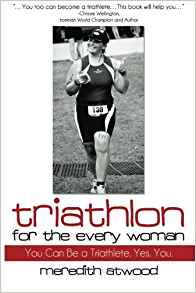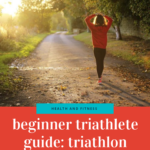This post may contain affiliate links. Full disclosure policy
THIS POST MAY CONTAIN REFERRAL LINKS. IF YOU CLICK THROUGH AND TAKE ACTION, I MAY BE COMPENSATED, AT NO ADDITIONAL COST TO YOU.
Over a year ago, I started dreaming about competing in my very first triathlon. A month from today, if all goes well, that dream will become a reality.
It has, quite literally, been a long road.
In the last eleven months, I have run, and biked, and swum hundreds of miles, some of them faster than I ever imagined would be possible. I’ve still got some training to do but, when the day comes, I’ll be ready.
I’ve worked hard and learned a lot. One of the things I’ve learned is that age and inexperience need not hinder athleticism. As long as you’re good health and willing to put in the effort, I’m convinced that just about anybody can complete a triathlon.
Here are some triathlon training tips for your first, over-fifty triathlon.
BEFORE YOU BEGIN
Triathlon training is physically demanding at any age. Check with your doctor to make sure you’re in overall good health before you begin training.
Joint issues, especially knees, can be a concern for over 50 athletes. It definitely was for me. I did some running in my 30s but ultimately gave it up because of my knees. Aching joints also marked the end of my skiing career.
Even so, I’ve had little to no knee problems over the course of my triathlon training. One of the great things about the triathlon is that two of the events – swimming and biking – are low-impact workouts.
By limiting myself to two training runs a week, building my mileage slowly, and making sure I iced my knees after my runs, I’ve been able to avoid knee pain and injury.
Wearing good running shoes also makes a big difference. I’ll be talking about that in later post, about choosing the right gear for your first triathlon.
PICK THE RIGHT RACE
Like people, triathlons come in all shapes and sizes – Ironman, Olympic, Ultra, Sprint, and Try-A-Tri. For your first race, you probably want one with a shorter distance, either a sprint or a Try-A-Tri.
Try-A-Tri races are specifically targeted toward people who have never done a triathlon. The distances are fairly short – perhaps to 200 to 400 meter swim, possibly in a pool, a bike ride of around 5 miles, and a one to two mile run. If you’re nervous about being able to tackle a tri, this can be a great way to start!
Sprint triathlons generally have a swim of between 500 to 750 meters, a bike ride somewhere between 10 and 12 miles, and a 5K run. However, there can be big variations. A sprint race in my area includes a 28-mile bike ride, which is why I decided against it. That’s just too much for me at this point.
Beyond distance, there are a lot of things to consider when choosing a first triathlon – terrain, temperature, elevation, and categories among them. Those factors can play a big role in your performance and overall experience.
Take the time to search out the right race for you. There are plenty of online listings for races. I like www.TriFind.com.
BEGIN WHERE YOU’RE AT
Of course, you can hire a professional trainer to help you prepare for your first triathlon but I chose to go it alone. I’m convinced you can do the same. If I could give you one piece of triathlon training advice for women over fifty, it would be to give yourself plenty of time.
How much time? That depends.
If you already run, bike, or swim on a regular basis, you might only need a few weeks to prepare. If you’ve starting from scratch, like I did, training for your first over-50 triathlon could take many months. I’ve spent nearly a year preparing for this race but I’m glad I did. Barring some unforeseen injury or circumstance, I feel confident that I’ll be able to finish the race.
Before you start training, assess where you are right now.
If your current fitness level is close to non-existent, it may be wise to begin with a program of brisk walking and some gym training. Or just start by running one mile (I’ve got a guide for that!). Circuit training and weight lifting will help build muscle you need to help increase your speed and endurance later on.
START OFF EASY
If you’re going from Couch Potato to Triathlete, your initial training schedule might look like this…
Monday: 30 minutes brisk treadmill walking
Tuesday: 25 minutes circuit training or weight lifting
Wednesday: Swimming (As many laps as you can manage comfortably)
Thursday: Rest Day
Friday: 25 minutes circuit training or weight lifting
Saturday: 30 minutes on stationary bike, easy pace
Sunday: Rest Day
BUILD UP SLOWLY
After a few weeks in the gym, building up your endurance, you’ll be ready to start training outside. An intermediate training schedule might look like this…
Monday: Run/Walk intervals, 30 minutes
Tuesday: Swimming – 10 laps (500 meters)
Wednesday: 5 miles biking
Thursday: Run/Walk intervals, 30 minutes
Friday: Swimming – 10 laps
Saturday: 5 miles biking
Sunday: Rest Day
During this intermediate stage of training, I used some fitness apps that really helped me measure my progress and increase my speed and endurance.
MapMyRide tracks my distance and speed and then stores my history so I can go back and see how I’ve improved over time. When you’re training over the long haul, it’s really encouraging to look back and see your progress.
My favorite was app is RunTracker. There’s a free version but I went ahead and paid $4.95 a month so I could use some of the specialized training programs. The Couch Potato to 5K training program was great! It’s designed for a 3-day per week run over two months. I used it twice a week over three months. By the time I was finished, I was running 5Ks comfortably and much faster than I could have ever imagined.
In addition to my fitness apps, I also downloaded Spotify to my phone. Being able to listen to my favorite music makes running so much more enjoyable.
THE LIGHT AT THE END OF THE TUNNEL
In the final few weeks before the race, you’ll need to step up your training and put in some extra miles and time.
This week, a month before my race, my training schedule looks like this…
Monday: Run 3 miles
Tuesday: Swim 15 laps (750 meters)
Wednesday: Bike 8 to 10 miles
Thursday: Swim 15 laps
Friday: Bike 9 miles and run 2 miles
Saturday: Bike 6 miles
Sunday: Rest day
You’ll note that I’ve added what I call “a double” to my schedule. Once a week, I bike and run on the same day. In these last weeks, I’ll increase those distances to 12 miles on the bike, and 3 miles running, the same distances I’ll need to cover on race day.
KNOWING IS BETTER THAN THINKING
Obviously I can’t tell you everything you need to know about your first triathlon in one blog post. Hopefully this will get you off to the right start. For more inspiration, look at this amazing book from SwimBikeRunMom. It’s called Triathlon for the Every Woman: You Can Be a Triathlete. Yes. You. It’s loaded with helpful information and tips for beginning triathlete.
However, at the end of the day, you can’t just read about triathlon training, you’ve got to do it.
Do you remember that children’s book, The Little Engine That Could? As the plucky, determined Little Engine climbed the hill, he chanted, “I think I can, I think I can, I think I can.”
Thinking you can is important but even better is knowing you can.
It hasn’t been easy but I’m very excited about this race. I’m under no illusions that I’ll be winning any ribbons on race day. But that’s okay.
My goal was to finish a triathlon. And now, with all these months of training under my belt, I know that I will finish, and finish strong.




